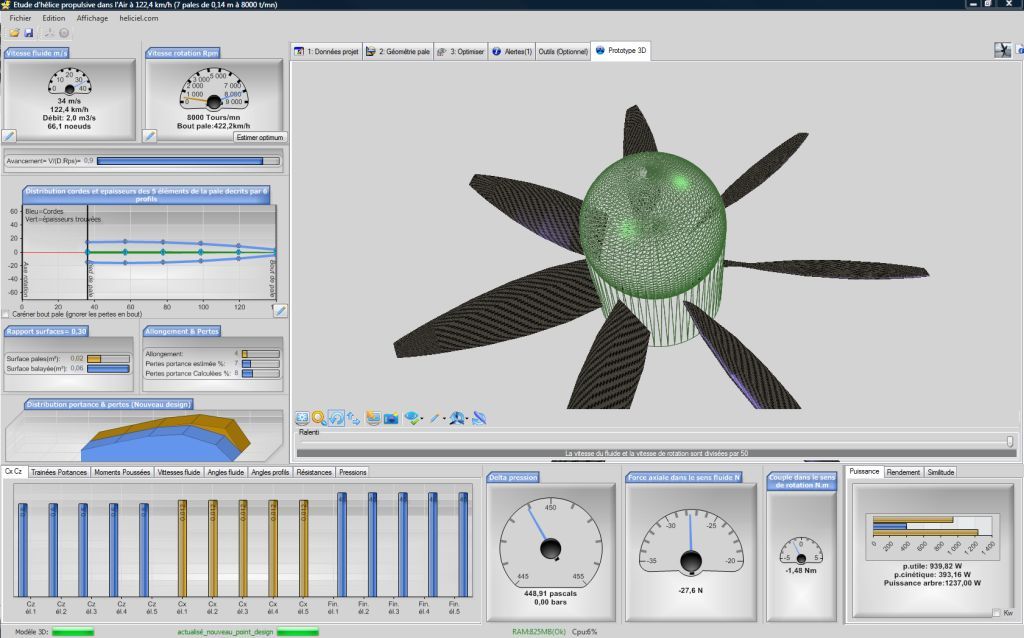see also: evolution propeller design methods
Design: propeller turbine, screw, aerial, marine, turbine, tidal, wind, kaplan, foil, wings, 3D. Discover heliciel software: Modeling aerial propeller in heliciel Modeling a wing mast sail in heliciel Wings or foils modeling in helicielUnderstand and master the propeller design: the blades number:

For wind propeller propulsion boat, plane or fan the question arises but the answer is always the result of a compromise. How to choose the right number of propellers blades?We talked in the article about the optimization of the propeller in general, about the influence of the number of blades. But the constraints of the specifications of a propeller are numerous, if the fluid is liquid (boat propellers), the number of blades can act also on cavitation.
Rather that an answer like "the best propeller blade number is 5", here is a reflection on the role of the number of blade in adapting propellers.
Why a more powerful engine would need more propeller blades?
To understand this problem, it is important to understand that a propeller must be tailored to the specific needs of an engine. The job of the propeller, is to absorb the power generated by the engine and to forward it to fluid passing through the propeller disc. The energy thus transferred to the air, to accelerate it, generates a thrust on the blades of the propeller. If the propeller and engine are not well matched in terms of engine power, the system loses efficiency and performance declines. When the engine power increases, the designer has a limited number of options for the design of a propeller able to efficiently absorb a greater power:- Increasing the angle of attack, of the propeller's blades . In doing so, the blade lift increases to give more energy to the air flow..
- Increasing the diameter of the propeller's disk ,which corresponds to lengthen the blades. Acting over a larger volume of air, the blades will perform the transfer of more energy.
- Increasing the speed of rotation of the propeller. The same amount of energy is transferred to the air, but in a shorter period of time.
- Increase the camber (or curvature) profiles. A propeller blade is composed of profiles, such as a wing. Increasing the camber of a propeller blade creates more thrust force, as the camber of a wing creates a greater lift force.
- Increase the chord (or width) propeller blades
- Increase the number of blades.
Unfortunately, many of these options, create more problems than they solve and are generally impractical for various reasons:
- Angle of attack: Length of the blade is determined by the angle that maximizes the aerodynamic efficiency of the blade (best lift / drag ratio). If this angle is changed, it is a loss of efficiency in order not to acquire another..
- Length of the blade: Increase the speed of the blade tip is a major problem (see below),As the propeller increases in size, the landing gear must be longer to avoid the blade hits the landing strip. This change has a domino effect on a number of other structures and induces weight problems.
- Rotational speed : If the speed at the blade tip exceeds the speed of sound, the aerodynamic performance of the profiles may fall.
- Camber Profile: Profiles are chosen to optimize the aerodynamic efficiency. By changing the profile, a type of efficiency is sacrificed again for another. Increasing the camber can also cause structural problems to the blade
we still have the last two options, the increase of the chord or the number of blades. Both have the effect of increasing the solidity of the propeller. Solidity, simply compares the propeller disk area occupied by solid components (blades), with the open area of air flow. The increased solidity of a propeller can transfer more power to the fluid.
While increasing the chord is the simplestbecause the area length ratio (aspect ratio) decreases and losses blade tip increases by lowering performance. Thus, increasing the number of blades is the most attractive approach. As the engine power has increased over the years, aircraft designers have increasingly added blades. Once they ran out of space on the propeller hub, designers have adopted the propeller contrarotative. they also won in performance, with the ability to retrieve the losses caused by the rotation of the fluid as it passes in the first propeller.
largely and freely based on an article by Jeff Scott.

 Global site map
Global site map Mecaflux
Mecaflux Tutorials Mecaflux Pro3D
Tutorials Mecaflux Pro3D Tutorials Heliciel
Tutorials Heliciel Mecaflux Store
Mecaflux Store Compare software functions
Compare software functions Quotes, Orders, Payment Methods
Quotes, Orders, Payment Methods project technical studies
project technical studies